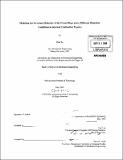| dc.contributor.advisor | Tian Tian. | en_US |
| dc.contributor.author | Xu, Dian | en_US |
| dc.contributor.other | Massachusetts Institute of Technology. Dept. of Mechanical Engineering. | en_US |
| dc.date.accessioned | 2011-03-24T20:27:48Z | |
| dc.date.available | 2011-03-24T20:27:48Z | |
| dc.date.copyright | 2010 | en_US |
| dc.date.issued | 2010 | en_US |
| dc.identifier.uri | http://hdl.handle.net/1721.1/61926 | |
| dc.description | Thesis (S.M.)--Massachusetts Institute of Technology, Dept. of Mechanical Engineering, 2010. | en_US |
| dc.description | Cataloged from PDF version of thesis. | en_US |
| dc.description | Includes bibliographical references (p. 71-72). | en_US |
| dc.description.abstract | In the process of designing internal combustion engine, piston ring plays an important role in fulfilling the requirements of camber gas sealing, friction reduction and lubrication oil consumption. The goal of this thesis is to have a better understanding of the ring behaviors under different working conditions in a structural level. This thesis is an extension of existing ring design tool. A model is built up to simulate the processes of changing ring states from one to another such as free or fit the ring. It revealed the sensitive characters of the piston ring tip; it expanded the field of application of the existing piston ring design tool; it also investigated the ring bore interaction in more conditions. This work removed the symmetric assumption in the existing tool. A new method that calculates ring free shape and ring bore contact force from ring ovality data is introduced for the first time. The analysis of ring bore interaction is widened. The model was applied to an industry ring design case. In this case it shows the free and fit procedure in this model is physically and mathematically reversible. It shows these procedures are direction independent. The contact force distribution changes when the ring is moving within the distorted bore. It also changes when the wetting or roughness situation is different. This model can calculate the ring free shape from asymmetric measured ovality data. It can also retrieve the desired contact force from it. The piston ring design tool is updated and implemented with these highly appreciable new features. This complete package has high efficiency and a wider practical field. | en_US |
| dc.description.statementofresponsibility | by Dian Xu. | en_US |
| dc.format.extent | 72 p. | en_US |
| dc.language.iso | eng | en_US |
| dc.publisher | Massachusetts Institute of Technology | en_US |
| dc.rights | M.I.T. theses are protected by
copyright. They may be viewed from this source for any purpose, but
reproduction or distribution in any format is prohibited without written
permission. See provided URL for inquiries about permission. | en_US |
| dc.rights.uri | http://dspace.mit.edu/handle/1721.1/7582 | en_US |
| dc.subject | Mechanical Engineering. | en_US |
| dc.title | Modeling the structural behavior of the piston rings under different boundary conditions in internal combustion engines | en_US |
| dc.type | Thesis | en_US |
| dc.description.degree | S.M. | en_US |
| dc.contributor.department | Massachusetts Institute of Technology. Department of Mechanical Engineering | |
| dc.identifier.oclc | 707351199 | en_US |
